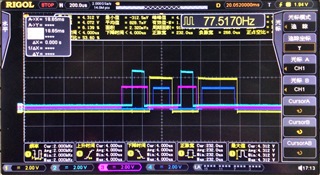Other Parts Discussed in Thread: CC2640R2F, , CC2540
Hi team,
Here's an issue from the customer may need your help:
The LNA,TX start of the master and slave are mapped. Checking the 4 IO level changes with an oscilloscope. Host is cc2642r, and Slave is cc2640r2f. The slave uses notify to transmit to the host. The characteristic value is 19 bytes (DLE should be turned on by default and 251 bytes set). The connection interval is 20 ms.
Pin Mapping:
Slaver DIO0 (CH4 dark blue) TX START
DIO1 (CH3 Purple) LNA
Master DIO0 (C1 yellow) LNA
DIO1 (CH2 Blue) TX START

Question 1: In theory, 19 bytes of data are sent at a time and should only be sent and received once on a connection event, that is, only one LNA, TX pin change. Now it's finds that LNA,TX has multiple level changes (1,2,3,4 times) on a connection. Why is that?
Question 2: The figure shows that the LNA of the slave is at the top, should it be the TX at the top of each cycle?
Could you help check this case? Thanks.
Best Regards,
Cherry

